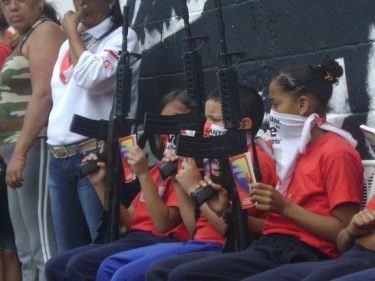Venezuelan social networks exploded with reactions after photos of a group of children posing with rifles [es] in one of Caracas’ most representative neighborhoods, Barrio 23 de Enero, went viral. The photos, taken and posted by the “La Piedrita” collective on their Facebook page [es], spread rapidly and generated a multitude of opinions, mainly ones of rejection.
In his post “En Venezuela Intentamos Construir Paz” (In Venezuela, We Try To Build Peace) [es], Luis Carlos Díaz shares other links that help contextualize the story and adds:
Un grupo de niños de una parroquia caraqueña fue usado para un acto político, portando armas de guerra y violando más de una ley bajo la mirada complaciente de autoridades y cuerpos de seguridad. Más allá de la obvia desviación ideológica-religiosa en las paredes, se cometieron hechos punibles con un grupo de niños. El Gobierno hoy manifestó su rechazo, pero es una medida estética en tanto permita su impunidad.
Meanwhile, Ludmila Vinogradoff comments on her post “Los Niños de la Revolución” (Children of the Revolution) [es]:
En la parroquia caraqueña donde fueron fotografiados los niños existen varios grupos radicales que dicen defender al gobierno de Chávez, amenazando con tomar las armas en caso de que el mandatario salga del poder. La pregunta que se hacen todos es; ¿quién financia a los grupos radicales y les suministra las armas de guerra?.
Days later, the collective filmed a video in which they sustained that their activities did not look to train children to use weapons. Nevertheless, other YouTube users highlighted the fact that one of the members passed by with a weapon hidden in the back of the shot, as well as the presence of the video's spokeswoman in the photos in question.
The photos were also a point of discussion in the media and a start-off point for a march organized by the same collective, La Piedrita, through which they demanded respect for the children in the photographs. According to posters that the collective shows in the images shared [es] on their Twitter account, “…the only thing that the children carried was the Constitution.”
Similarly, they responded to the media saying the children were not carrying real weapons and that it was all part of a “theatrical play.” Reactions on Twitter discredited the statement.
Ytzel Pérez (@ytzelpérez) [es] was one of the users who criticized the collective's arguments, and Eduardo Ponte (@acaballoregalao) [es] posted his thoughts under the hashtag #insólito [es]:
@ytzelpérez: Buenos días a todo mi TL, sorprendida ahora según y q los Niños d la Piedrita estaban haciendo una “obra d Teatro” eso no se los cree nadie!
@acaballoregalao: INSÓLITO: La Piedrita asegura que los fusiles M-16 eran de plástico y que los niños hacian una obra de teatro
#FAIL
@acaballoregalao: OUTRAGEOUS: La Piedrita assures everyone that the M-16 rifles were plastic and that the children were putting on a play. #FAIL
Ministerial representatives and personalities, as well as members of civil and non-governmental organizations communicated their rejection of children's incitement in armed conflicts. However, it is unlikely that this debate will end soon.
For many, these images have been used to manipulate public opinion against the government. For others, the images represent a warning in terms of the resources and the limits of pro-Chávez groups which the government could use alternatively from the Armed Forces. The fate of those responsible from the La Piedrita collective before the authorities of the Presidential Commission for the Control of Arms, Ammunition, and Disarmament [es] is yet to be seen.








1 comment